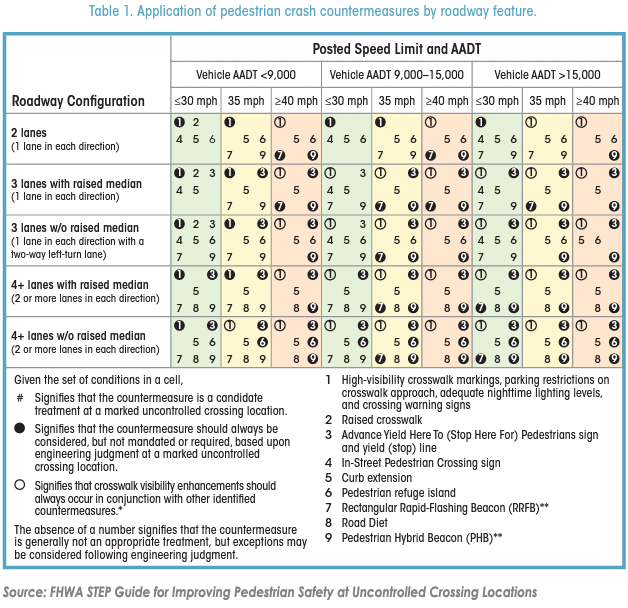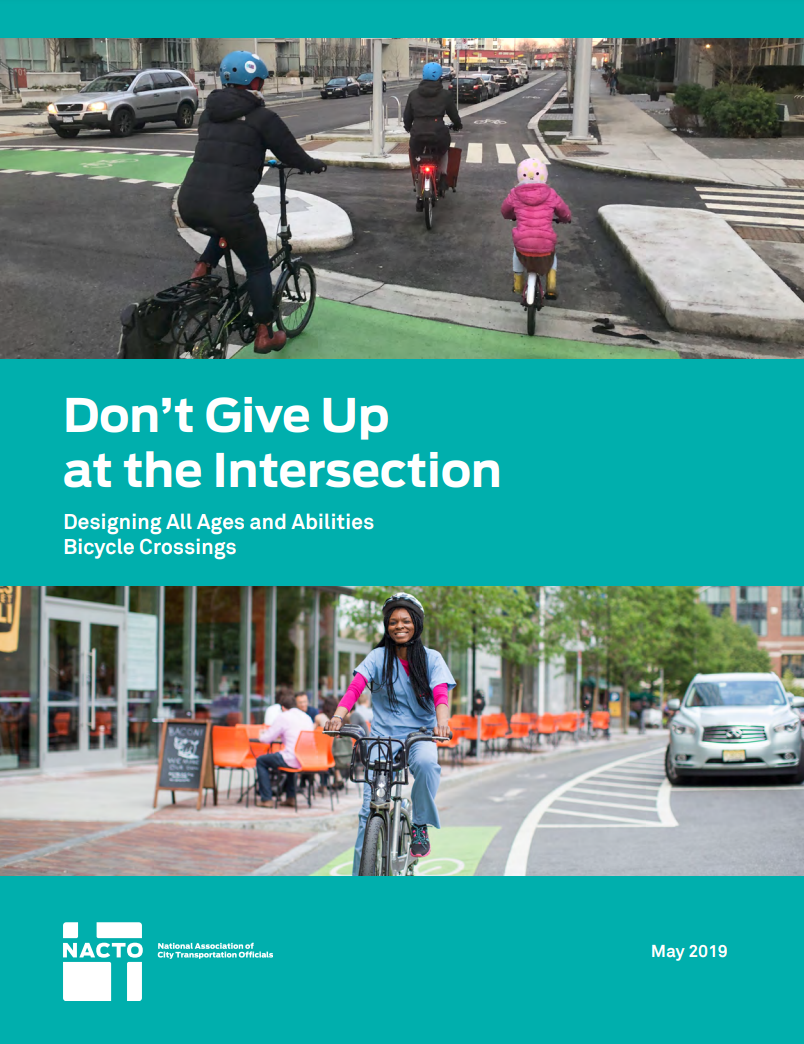Countywide Bikeways facilities should continue protection through intersections. Where feasible, provide protected intersections for separated and protected facilities. Ensure safe and comfortable crossings of arterials for bicycle boulevards.
In intersection design development, careful evaluation of the bicycle network, conflicting vehicle turn movements and volumes, and available right of way should determine the appropriate intersection design. Throughout this evaluation, safety should take top priority. Like with considerations for bikeway separation, intersection design can be challenging. The national guides and resources on this page provide some tools for navigating cost and spatial constraints. Forthcoming resources tailored to Alameda County will provide additional guidance and local project examples for phasing and implementation of All Ages and Abilities (AAA) intersection design.
National best practice resources are available through NACTO’s Don’t Give Up at the Intersection and the MassDOT Separated Bikeway Planning and Design Guide, Chapters 4 and 6. The Federal Highway Administration (FHWA) provides guidance on driveways.
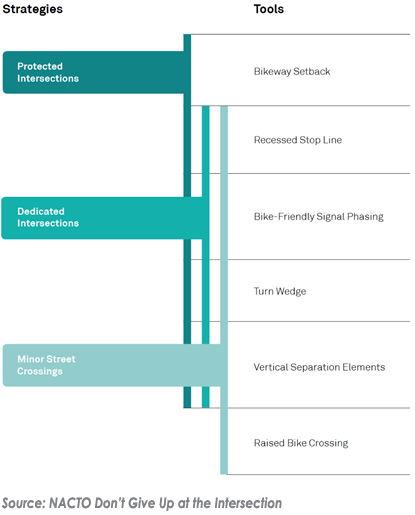
NACTO Don’t Give Up at the Intersection
Protected intersection design supports the continuation of AAA facilities through intersections, especially at the intersection of multiple streets in a local bikeway network. Protected intersections use corner islands, curb extensions, and color paint to delineate bicycle and pedestrian movements across an intersection. Slower driving speeds and shorter crossing distances increase multi-modal safety, while separated bike lane crossings allow people biking to make left turns and transition to intersecting AAA bikeways without merging across lanes of through-moving traffic. Where space is limited and intersection geometry may preclude a full protected intersection, a dedicated intersection combined with dedicated signal phasing can also effectively reduce conflicts and improve bicyclist comfort at intersections. For further detail on protected and dedicated intersection design, refer to Chapter 4 of the MassDOT Guide.Protected Intersection Diagram
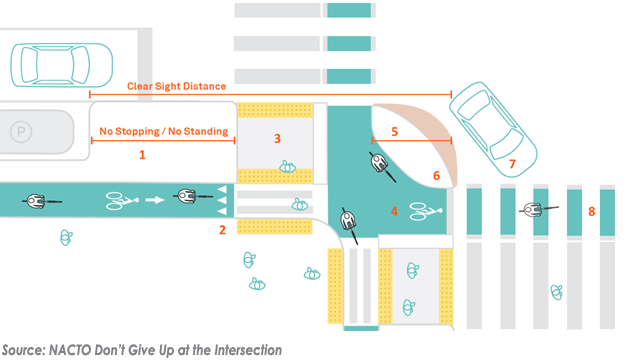
MassDOT Separated Bike Lane Guide, Chapter 6
Signal design along separated bike lane corridors is critical to the safe and successful implementation, especially at intersections with high conflicting turn movements. In these contexts, dedicated phasing for turning vehicles and people bicycling reduces conflicts by separating users in time. Where fully separate phasing for bicycles is not warranted, a leading bicycle/pedestrian interval can improve bicyclist visibility for turning vehicles. Chapter 6 of the MassDOT Separated Bike Lane Planning and Design Guide provides detailed considerations for phasing scheme options, signal equipment, and signal timing. The chapter provides thresholds for conflicting vehicle volumes that require consideration of dedicated phasing. NACTO’s Don’t Give Up at the Intersection provides additional resources and considerations for signal design. Key considerations for signal design include:- Existing signal equipment and visibility
- Conflicting vehicle turn volumes
- Signal timing, phasing, and intersection clearance
- Sight lines
- Actuation and detection
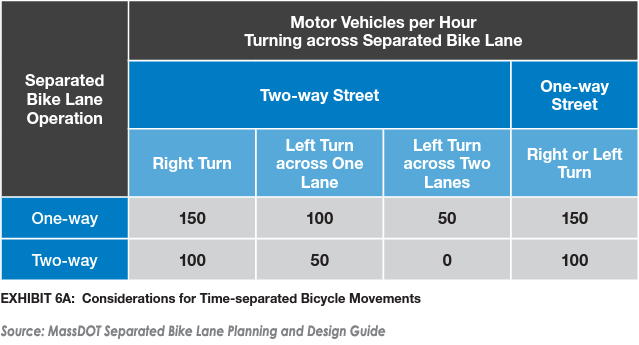
FHWA Guide, Chapter 5, Step 3
The FHWA Separated Bike Lane Planning and Design Guide provides sight distance guidelines for driveways and small intersections. In general, 20 feet of clear space (parking restriction) on both sides of a driveway are required to ensure clear field of view for drivers entering and exiting driveways to see people and yield to people bicycling. In some cities, less daylighting is used at single-family driveways. This is generally implemented on a case-by-case basis. Chapter 5, Step 3 provides detailed midblock considerations, including specific recommendations and considerations for driveways on one-way or two-way streets and with one-way or two-way separated bike lanes.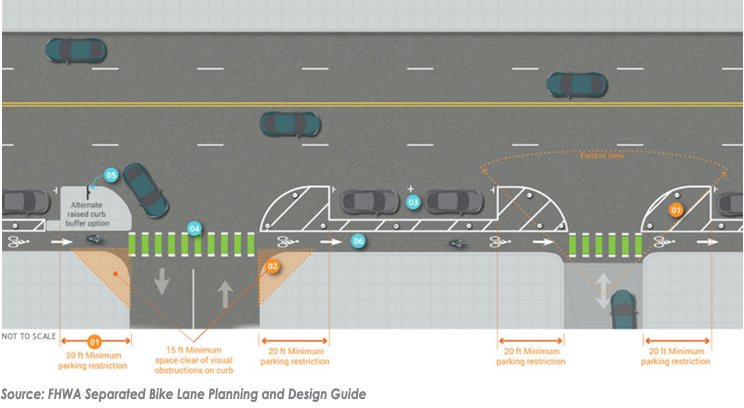
FHWA STEP Guide for Improving Pedestrian Safety at Uncontrolled Crossing Locations
Residential roads with low traffic volumes and speeds (<2000 ADT /<20 MPH), and designed as bicycle boulevards, can feel safe and comfortable for users of AAA as part of the Countywide Bikeways Network. Along many bicycle boulevards, arterial crossings—especially at uncontrolled locations—pose a significant barrier to access, safety, and comfort along the bike routes. These uncontrolled bikeway crossings typically correspond with crosswalks where pedestrians are the most vulnerable user, the FHWA STEP Guide for Improving Pedestrian Safety at Uncontrolled Crossing Locations provides the best guidance for selecting crossing enhancements appropriate for each context. When selecting the appropriate crossing treatments, designers should consider bicycle use and access. For example, median refuges need breaks along the bikeway alignment and bicycle actuation is needed for pedestrian hybrid beacons or pedestrian signals.